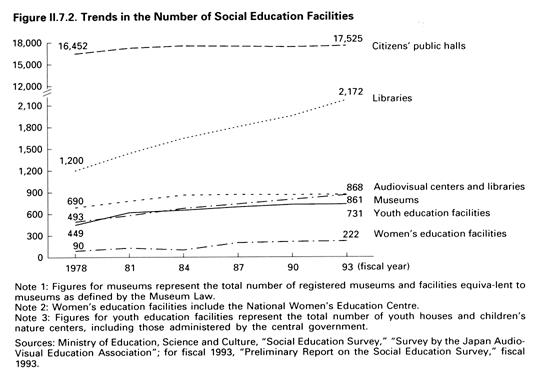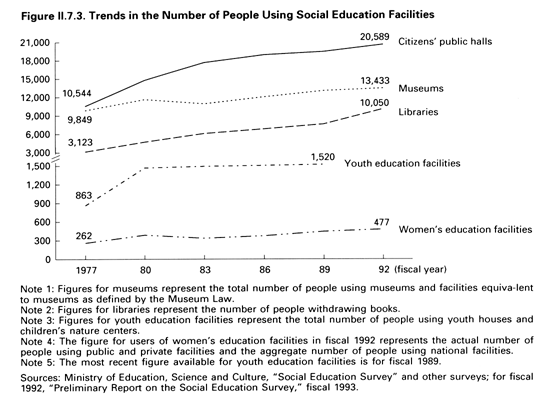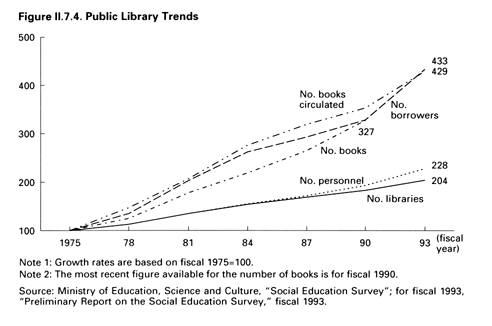| Home > Policy > White Paper, Notice, Announcement > White Paper > JAPANESE GOVERMENT POLICICIES IN EDUCATION, SCIENCE AND CULTURE 1994 > PART II Chapter 7 Section 6 1 | ||
Social education facilities provide bases for learning activities. They include citizens' public halls, libraries, museums, youth education facilities, women's education facilities, and audiovisual centers ( Figure II.7.2, Figure II.7.3 ). Recently an increasing number of prefectural governments have been responding to citizen's learning needs by establishing comprehensive social education facilities under such names as lifelong learning promotion centers.
The Ministry of Education, Science and Culture provides local governments that establish public social education facilities with grants to cover part of the construction costs. Since fiscal 1992 the Ministry has also provided subsidies for social education facility revitalization programs. The purpose of these programs is to revitalize lifelong learning activities in local areas through the independent planning and development of new programs centered on social education facilities to cope with local issues and demand for learning.
Lifelong learning promotion centers are discussed in part 2, chapter 2. Youth education facilities, women's education facilities, and audiovisual centers are examined in the relevant sections of the present chapter.


Citizens' public halls play an important role as core facilities for social education activities in a familiar community setting. There were 17,525 such facilities in Japan as of October 1993. The goal is to establish one hall in each lower secondary school district at the city (ward) level and one hall in each elementary school district in towns and villages. The establishment ratios are 83% for cities (wards), 48% for towns and villages, and 61% overall.
The Ministry of Education, Science and Culture contributes to the establishment and improvement of citizens' public halls by providing facility development subsidies. In recent years the Ministry has also been working to develop large-scale citizens' public halls equipped with various facilities and functions to serve as core lifelong learning centers for entire municipalities. The aim of this approach is to enhance lifelong learning promotion systems, especially at the municipal level.
Libraries are community facilities for the collection, cataloguing, and provision of books, other materials, and information required for learning activities. Japan has 2,138 public libraries established by local governments and 34 private libraries established by incorporated and other organizations (as of October 1993).
Libraries have been developed and expanded over the years. Over the past 15 years the number of libraries has increased 1.8 times, from 1,200 to 2,172, while the number of books withdrawn has grown steadily, increasing 4.3 times over the same period ( Figure II.7.4 ).
The Ministry of Education, Science and Culture provides subsidies for the construction of libraries and the development of library information networks linking prefectural and municipal libraries. The Ministry also provides assistance to municipalities that undertake programs to improve library facilities, such as the provision of mobile libraries, collections of Braille publications, and magnifiers for reading.
In June 1992 the Ministry received a report from the Expert Committee on Libraries of the Lifelong Learning Council concerning standards for the construction and operation of public libraries. On the basis of this report the Ministry has been encouraging local governments to give increased priority to the construction and expansion of public libraries. The Ministry has also increased its efforts to promote libraries, including the provision of training for newly appointed head librarians in public libraries, the implementation of district public library research conferences, and the preparation of guidance materials.

Museums play an important role as social education facilities. They support learning activities by providing access to material resources. As of October 1993, 618 museums were registered with prefectural boards of education, and a further 243 were designated by the Minister of Education, Science and Culture or prefectural boards of education as facilities equivalent to museums. There are also 2,844 institutions engaged in activities similar to those of museums.
In recent years local governments have developed a variety of museums that reflect regional characteristics. There is a need, however, for efforts to improve and expand the activities of museums, including the enhancement of exhibitions and educational activities and the formation of information networks. The Ministry of Education, Science and Culture is therefore providing subsidies for the development of museum facilities. In addition, the Ministry is encouraging the use of a low-interest loan system established by the Japan Development Bank and other institutions in fiscal 1991 for the development and improvement of private museums.
Another important priority for the enhancement of museum activities is the improvement of the caliber of curators and other museum personnel. In fiscal 1994 a new training program was established for curators of natural science museums. In addition, a National Conference of Museum Directors has been held to provide a forum for the discussion of issues relating to the promotion of museum activities.
The National Science Museum, the only comprehensive national science museum in Japan, undertakes research, surveys, and educational activities, as well as the collection, preservation, and display of resources relating to natural history and other fields in the natural sciences. The museum is constantly updating its exhibits-for example, replacing exhibits relating to evolution, installing a flight simulator, and constructing a life-size model of a blue whale.
The museum's educational activities include the provision of learning opportunities through programs for young people, families, and adults and in-service training programs designed to improve the caliber of museum personnel and schoolteachers. In addition, the museum is fostering volunteers to provide guidance and advice in the museum, thus providing people with the opportunity for volunteer activities. Research, surveys, and educational activities are also carried out by the Institute for Nature Study (Minato Ward, Tokyo) and the Tsukuba Research Resource Center (Tsukuba City, Ibaraki Prefecture; the center includes the Tsukuba Botanical Garden and the Showa Memorial Institute), both of which are attached to the National Science Museum.
| Back to Top | MEXT HOME |